WON-OCDMA System Based on MW-ZCC Codes for Applications in Optical Wireless Sensor Networks
Abstract
:1. Introduction
2. Code Construction
3. System Description
4. Simulation Results
5. Theoretical Analysis
Obtained Results
6. Discussion
7. Conclusions
Author Contributions
Funding
Institutional Review Board Statement
Informed Consent Statement
Data Availability Statement
Acknowledgments
Conflicts of Interest
References
- Majumder, M.; Gangopadhyay, T.K.; Chakraborty, A.K.; Dasgupta, K.; Bhattacharya, D.K. Fibre Bragg gratings in structural health monitoring-Present status and applications. Sens. Actuators A Phys. 2008. [Google Scholar] [CrossRef]
- Li, H.N.; Li, D.S.; Song, G.B. Recent applications of fiber optic sensors to health monitoring in civil engineering. Eng. Struct. 2004, 26, 1647–1657. [Google Scholar] [CrossRef]
- Shabaneh, A.; Girei, S.; Arasu, P.; Rahman, W.; Bakar, A.; Sadek, A.; Lim, H.; Huang, N.; Yaacob, M. Reflectance response of tapered optical fiber coated with graphene oxide nanostructured thin film for aqueous ethanol sensing. Opt. Commun. 2014, 331, 320–324. [Google Scholar] [CrossRef]
- Woyessa, G.; Nielsen, K.; Stefani, A.; Markos, C.; Bang, O. Temperature insensitive hysteresis free highly sensitive polymer optical fiber Bragg grating humidity sensor. Opt. Express 2016, 24, 1206. [Google Scholar] [CrossRef] [Green Version]
- Li, C.; Zhao, Y.G.; Liu, H.; Wan, Z.; Zhang, C.; Rong, N. Monitoring second lining of tunnel with mounted fiber Bragg grating strain sensors. Autom. Constr. 2008, 17, 641–644. [Google Scholar] [CrossRef]
- Rahimian, F.P.; Seyedzadeh, S.; Glesk, I. OCDMA-based sensor network for monitoring construction sites affected by vibrations. J. Inf. Technol. Constr. 2019, 24, 299–317. [Google Scholar]
- Lu, S.W.; Xie, H.Q. Strengthen and real-time monitoring of RC beam using “intelligent” CFRP with embedded FBG sensors. Constr. Build. Mater. 2007, 21, 1839–1845. [Google Scholar] [CrossRef]
- Unzu, R.; Nazabal, J.A.; Vargas, G.; Hernández, R.J.; Fernández-Valdivielso, C.; Urriza, N.; Galarza, M.; Lopez-Amo, M. Fiber optic and KNX sensors network for remote monitoring a new building cladding system. Autom. Constr. 2013, 30, 9–14. [Google Scholar] [CrossRef]
- Dawood, N.; Rahimian, F.; Seyedzadeh, S.; Sheikhkhoshkar, M. Enabling the Development and Implementation of Digital Twins: Proceedings of the 20th International Conference on Construction Applications of Virtual Reality; Teesside University: Middlesbrough, UK, 2020; p. 389. [Google Scholar]
- Pour Rahimian, F.; Seyedzadeh, S.; Oliver, S.; Rodriguez, S.; Dawood, N. On-demand monitoring of construction projects through a game-like hybrid application of BIM and machine learning. Autom. Constr. 2020, 110, 103012. [Google Scholar] [CrossRef]
- Takahashi, N.; Yoshimura, K.; Takahashi, S. Fiber Bragg grating vibration sensor using incoherent light. Jpn. J. Appl. Phys. Part 1 Regul. Pap. Short Notes Rev. Pap. 2001, 40, 3632–3636. [Google Scholar] [CrossRef]
- Zhang, Z.; Bao, X. Continuous and damped vibration detection based on fiber diversity detection sensor by Rayleigh backscattering. J. Light. Technol. 2008, 26, 832–838. [Google Scholar] [CrossRef]
- Ge, Y.; Kuang, K.S.; Quek, S.T. Development of a low-cost bi-axial intensity-based optical fibre accelerometer for wind turbine blades. Sens. Actuators A Phys. 2013, 197, 126–135. [Google Scholar] [CrossRef]
- Udd, E.; Spillman, W.B., Jr. Fiber Optic Sensors: An Introduction for Engineers and Scientists; John Wiley & Sons: Hoboken, NJ, USA, 2011; pp. 451–462. [Google Scholar]
- Taiwo, A.; Seyedzadeh, S.; Taiwo, S.; Sahbudin, R.K.Z.; Yaacob, M.H.; Mokhtar, M. Performance and comparison of fiber vibration sensing using SAC-OCDMA with direct decoding techniques. Opt. Int. J. Light Electron Opt. 2014, 125, 4803–4806. [Google Scholar] [CrossRef]
- Noura, A.; Seyedzadeh, S.; Anas, S.B. Simultaneous vibration and humidity measurement using a hybrid WDM/OCDMA sensor network. In Proceedings of the 4th International Conference on Photonics (ICP 2013), Melaka, Malaysia, 28–30 October 2013; pp. 163–165. [Google Scholar] [CrossRef]
- Taiwo, A.; Taiwo, S.; Sahbudin, R.K.Z.; Yaacob, M.H.; Mokhtar, M. Fiber vibration sensor multiplexing techniques for quasi-distributed sensing. Opt. Laser Technol. 2014, 64, 34–40. [Google Scholar] [CrossRef]
- Seyedzadeh, S.; Rahimian, F.P.; Glesk, I.; Kakaee, M.H. Variable weight spectral amplitude coding for multiservice OCDMA networks. Opt. Fiber Technol. 2017, 37, 53–60. [Google Scholar] [CrossRef]
- Anas, S.B.A.; Seyedzadeh, S.; Mokhtar, M.; Sahbudin, R.K.Z. Variable weight Khazani-Syed code using hybrid fixed-dynamic technique for optical code division multiple access system. Opt. Eng. 2016, 55, 106101. [Google Scholar] [CrossRef] [Green Version]
- Seyedzadeh, S.; Glesk, I.; Pour Rahimian, F.; Kwong, W.C. Variable weight code division multiple access system for monitoring vibration of unequally distributed points. In Proceedings of the International Conference on Transparent Optical Networks, Angerrs, France, 9–13 July 2019; pp. 1–4. [Google Scholar] [CrossRef]
- Kwong, W.; Yang, G.C. Multiple-Length Multiple-Wavelength Optical Orthogonal Codes for Optical CDMA Systems Supporting Multirate Multimedia Services. IEEE J. Sel. Areas Commun. 2004, 22, 1640–1647. [Google Scholar] [CrossRef]
- Liang, W.; Yin, H.; Qin, L.; Wang, Z.; Xu, A. A new family of 2D variable-weight optical orthogonal codes for OCDMA systems supporting multiple QoS and analysis of its performance. Photonic Netw. Commun. 2008, 16, 53–60. [Google Scholar] [CrossRef]
- Seyedzadeh, S.; Moghaddasi, M.; Anas, S. Variable-weight optical code division multiple access system using different detection schemes. J. Telecommun. Inf. Technol. 2016, 2016, 50–59. [Google Scholar]
- Seyedzadeh, S.; Mahdiraji, G.A.; Sahbudin, R.K.Z.; Abas, A.F.; Anas, S.B.A. Experimental demonstration of variable weight SAC-OCDMA system for QoS differentiation. Opt. Fiber Technol. 2014, 20, 495–500. [Google Scholar] [CrossRef]
- Cvijetic, N.; Wilson, S.G.; Brandt-Pearce, M. Receiver optimization in turbulent free-space optical MIMO channels with APDs and Q-ary PPM. IEEE Photonics Technol. Lett. 2007, 19, 103–105. [Google Scholar] [CrossRef]
- Sahbudin, R.K.Z.; Kamarulzaman, M.; Hitam, S.; Mokhtar, M.; Anas, S.B.A. Performance of SAC OCDMA-FSO communication systems. Opt. Int. J. Light Electron Opt. 2013, 124, 2868–2870. [Google Scholar] [CrossRef]
- Moghaddasi, M.; Taiwo, A.; Seyedzadeh, S.; Boroon, M.; Hitam, S.; Anas, S. Performance analysis of spectral amplitude coding-optical code division multiple access (SAC-OCDMA) in free space optical networks with a multi-wavelength laser source. Lasers Eng. 2017, 38, 67–80. [Google Scholar]
- Alyan, E.; Aljunid, S. Development of wireless optical CDMA system for biosignal monitoring. Optik 2017, 145, 250–257. [Google Scholar] [CrossRef]
- Anuar, M.S.; Aljunid, S.; Saad, N.M.; Hamzah, S.M. New design of spectral amplitude coding in OCDMA with zero cross-correlation. Opt. Commun. 2009, 282, 2659–2664. [Google Scholar] [CrossRef]
- Ahmed, N.; Aljunid, S.; Fadil, A.; Ahmad, R.; Rashid, M. Performance enhancement of OCDMA system using NAND detection with modified double weight (MDW) code for optical access network. Opt. Int. J. Light Electron Opt. 2013, 124, 1402–1407. [Google Scholar] [CrossRef]
- Mamdoohi, G.; Sarmani, A.R.; Abas, A.F.; Yaacob, M.H.; Mokhtar, M.; Mahdi, M.A. 20 GHz spacing multi-wavelength generation of Brillouin-Raman fiber laser in a hybrid linear cavity. Opt. Express 2013, 21, 18724. [Google Scholar] [CrossRef] [PubMed]
- Mahdieh, M.H.; Pournoury, M. Atmospheric turbulence and numerical evaluation of bit error rate (BER) in free-space communication. Opt. Laser Technol. 2010, 42, 55–60. [Google Scholar] [CrossRef]
- Moghaddasi, M.; Mamdoohi, G.; Noor, A.S.M.; Mahdi, M.A.; Anas, S.B.A. Development of SAC–OCDMA in FSO with multi-wavelength laser source. Opt. Commun. 2015, 356, 282–289. [Google Scholar] [CrossRef]
- Matem, R.; Aljunid, S.; Junita, M.; Rashidi, C.; Ahmed, I.S. Photodetector effects on the performance of 2D Spectral/Spatial code in OCDMA system. Optik 2019, 178, 1051–1061. [Google Scholar] [CrossRef]
- Rodrigues, G.K.; Carneiro, V.G.A.; da Cruz, A.R.; Giraldi, M.T.M.R. Evaluation of the strong turbulence impact over free-space optical links. Opt. Commun. 2013, 305, 42–47. [Google Scholar] [CrossRef]
- Wang, Z.; Zhong, W.D.; Fu, S.; Lin, C. Performance comparison of different modulation formats over free-space optical (FSO) turbulence links with space diversity reception technique. IEEE Photonics J. 2009, 1, 277–285. [Google Scholar] [CrossRef]
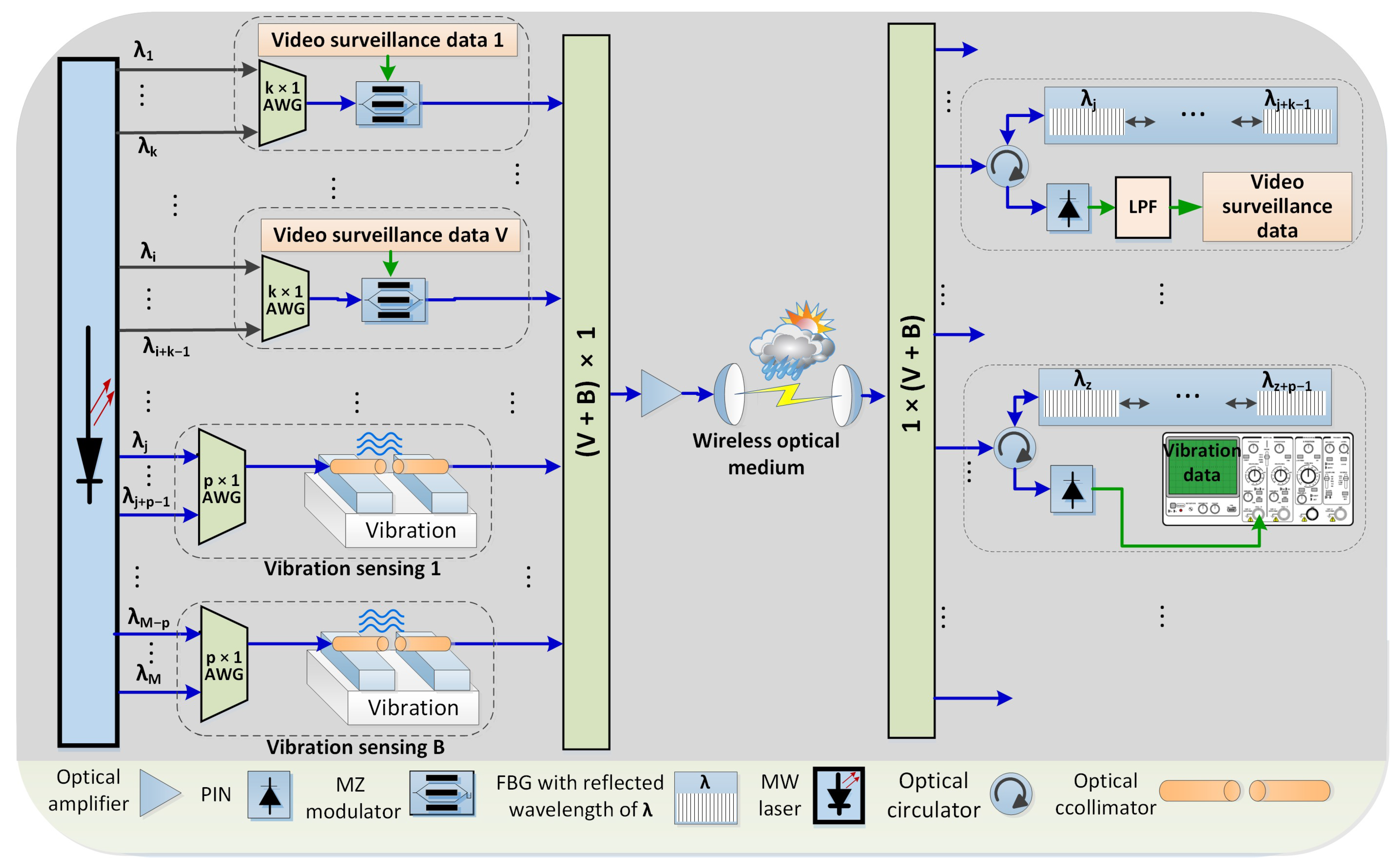

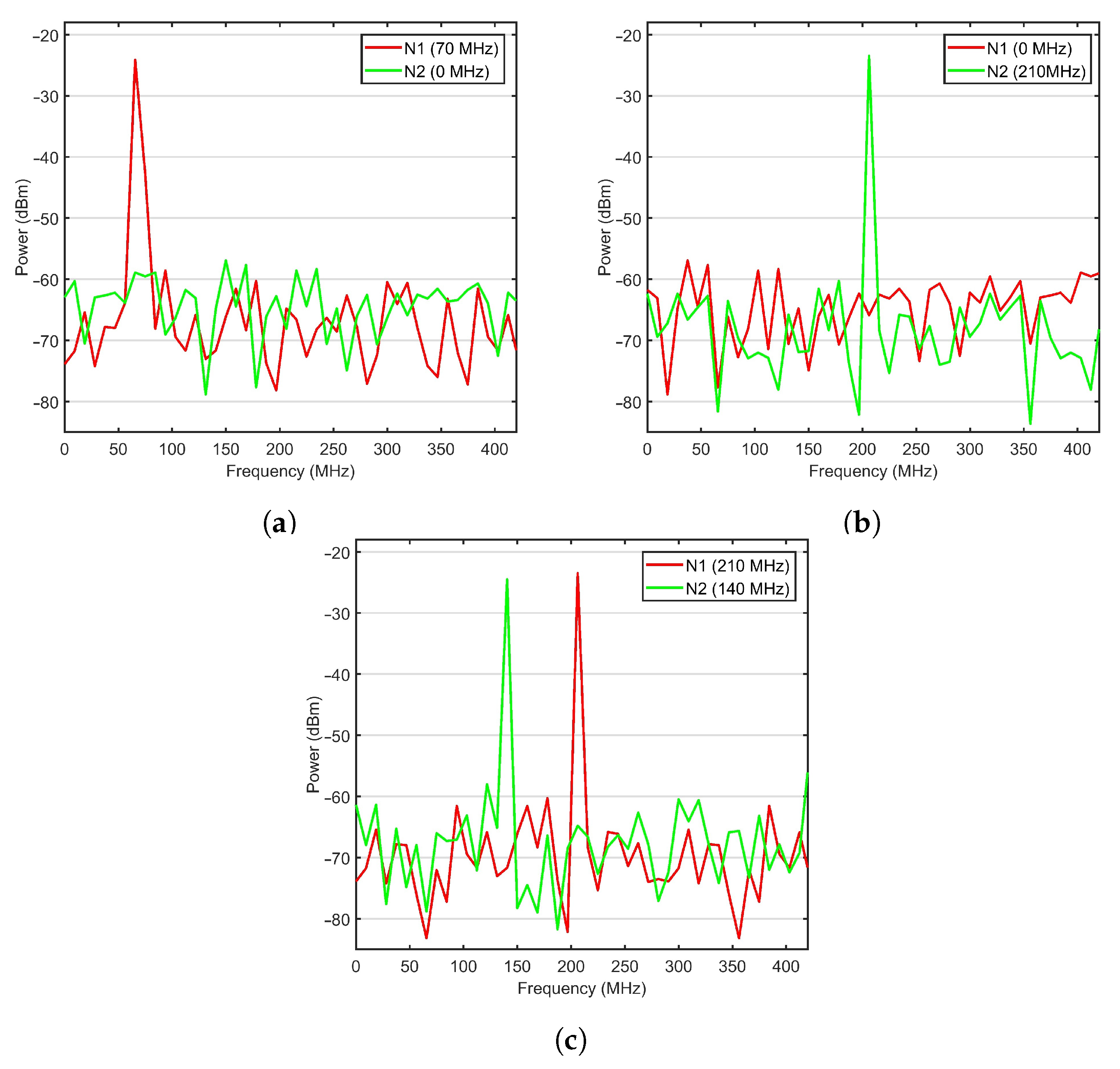

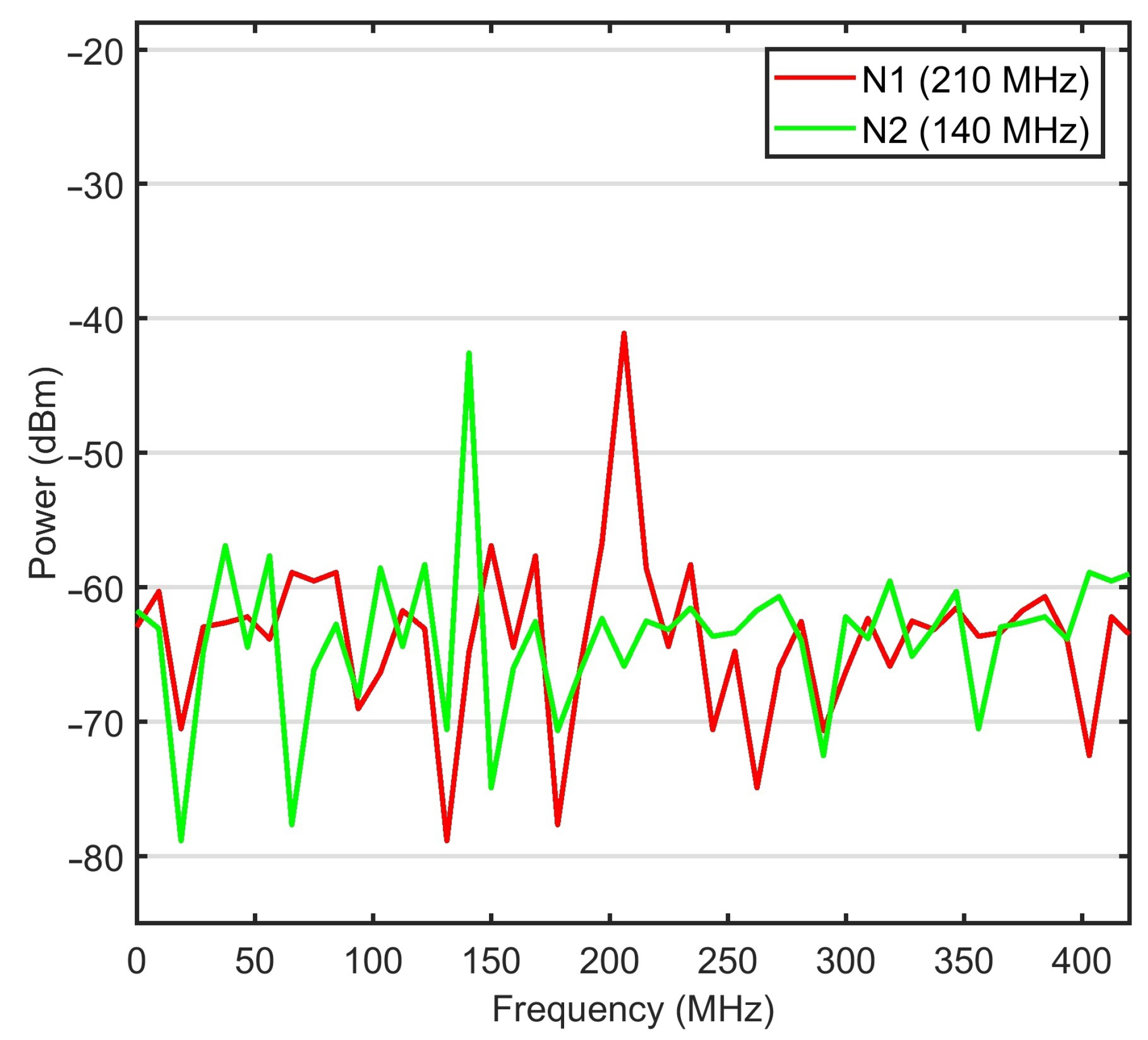
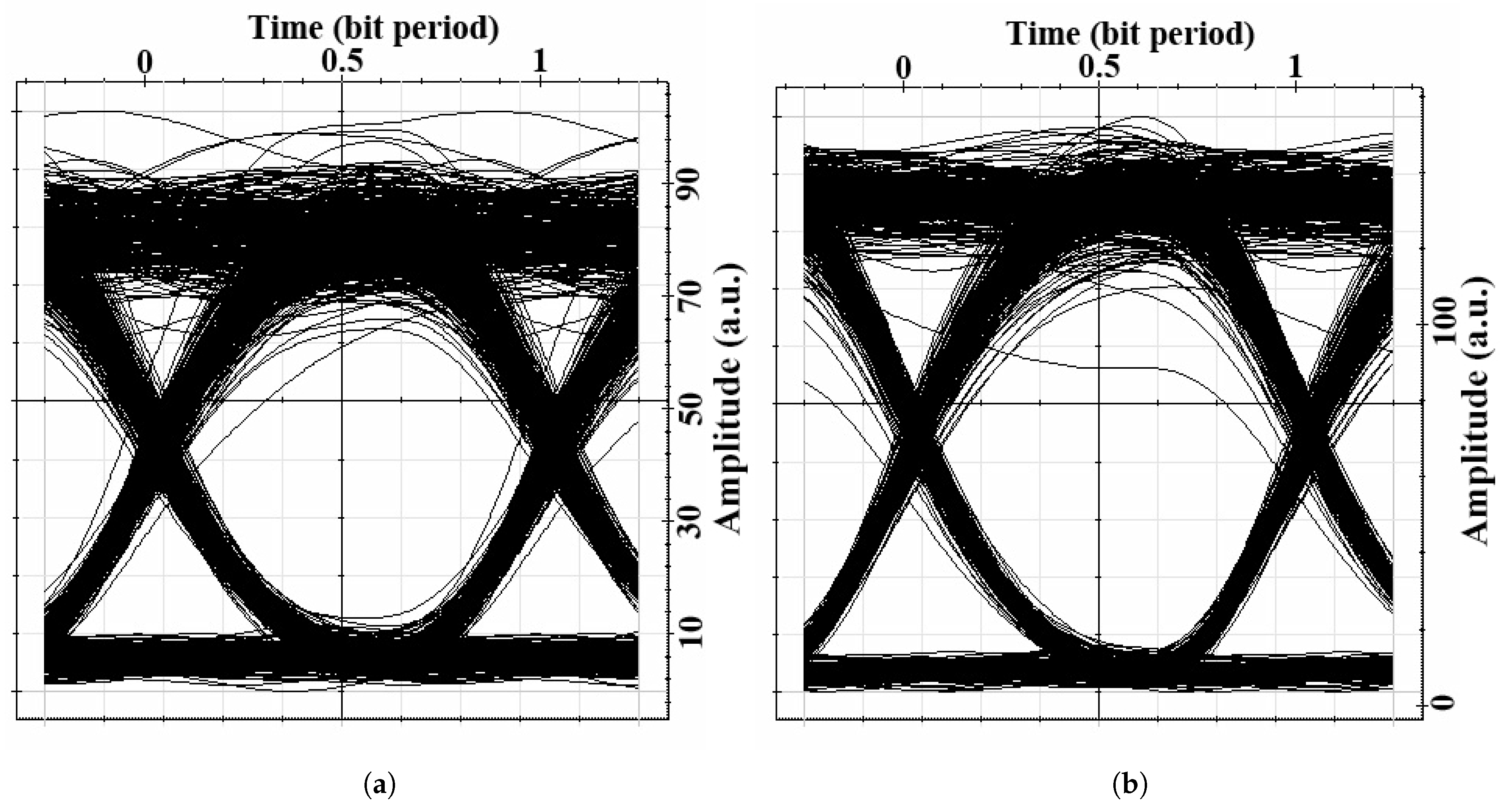
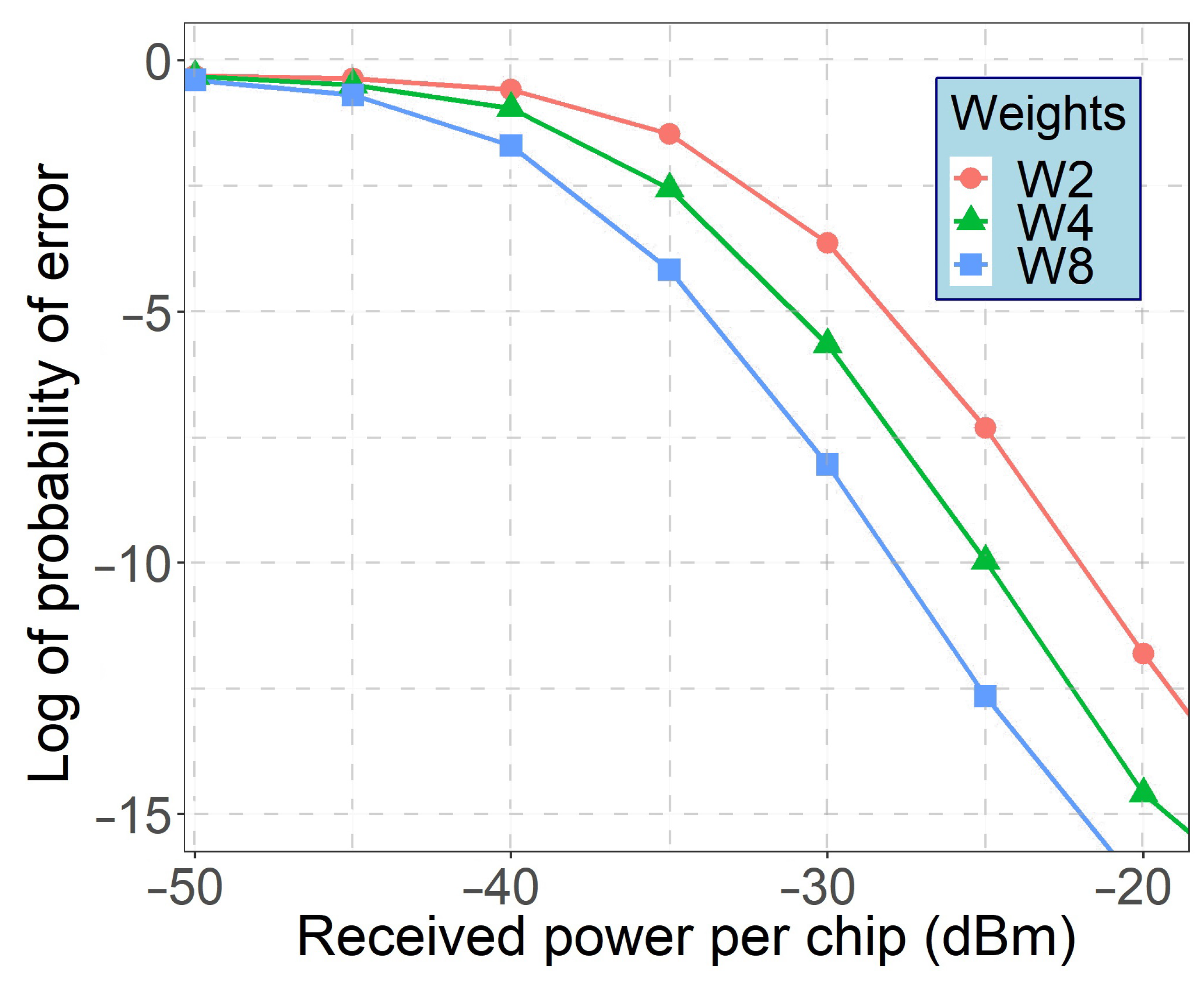


| Node | Exp1 | Exp2 | Exp3 |
|---|---|---|---|
| N1 | 70 MHz | 0 MHz | 210 MHz |
| N2 | 0 MHz | 210 MHz | 140 MHz |
| Symbol | Parameter | Value |
|---|---|---|
| Beam divergence | 0.5 mrad | |
| Operating wavelength | 1550 nm | |
| D | Receiver aperture diameter | 8 cm |
| Electrical bandwidth | 2.5 GHz | |
| Rytov variance | 1 | |
| Weather attenuation | 3 dB/km | |
| Crosstalk power | −30 dBm | |
| Total transmitted power | 20 dBm |
Publisher’s Note: MDPI stays neutral with regard to jurisdictional claims in published maps and institutional affiliations. |
© 2021 by the authors. Licensee MDPI, Basel, Switzerland. This article is an open access article distributed under the terms and conditions of the Creative Commons Attribution (CC BY) license (http://creativecommons.org/licenses/by/4.0/).
Share and Cite
Seyedzadeh, S.; Agapiou, A.; Moghaddasi, M.; Dado, M.; Glesk, I. WON-OCDMA System Based on MW-ZCC Codes for Applications in Optical Wireless Sensor Networks. Sensors 2021, 21, 539. https://doi.org/10.3390/s21020539
Seyedzadeh S, Agapiou A, Moghaddasi M, Dado M, Glesk I. WON-OCDMA System Based on MW-ZCC Codes for Applications in Optical Wireless Sensor Networks. Sensors. 2021; 21(2):539. https://doi.org/10.3390/s21020539
Chicago/Turabian StyleSeyedzadeh, Saleh, Andrew Agapiou, Majid Moghaddasi, Milan Dado, and Ivan Glesk. 2021. "WON-OCDMA System Based on MW-ZCC Codes for Applications in Optical Wireless Sensor Networks" Sensors 21, no. 2: 539. https://doi.org/10.3390/s21020539
APA StyleSeyedzadeh, S., Agapiou, A., Moghaddasi, M., Dado, M., & Glesk, I. (2021). WON-OCDMA System Based on MW-ZCC Codes for Applications in Optical Wireless Sensor Networks. Sensors, 21(2), 539. https://doi.org/10.3390/s21020539








